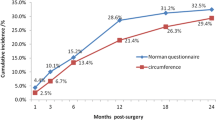Abstract
Purpose
In clinical practice, noticeable differences are seen in patient response to the treatment of breast cancer-related lymphedema. Although some factors influencing response to treatment are mentioned in the literature, there is no sufficient evidence and results are confusing. For this reason, our objective in this study is to identify predictive and response-related factors for response to treatment of breast cancer-related lymphedema.
Methods
We analyzed data retrospectively from the files of patients with breast cancer-related lymphedema between 2006 and 2012. Patient demographics, clinical variables, and patient variables were recorded. Circumference measurements of lymphedema and healthy arms were recorded. We used a computer program (Limb Volumes Professional version 5.0) to transform these values to limb volumes in milliliters.
Results
The average age of 331 patients was 54.4 ± 10.9. The average length of lymphedema treatment was 2.92 ± 1.3 weeks. A statistically significant positive correlation was found between postoperative weight gain and postoperative duration, number of chemotherapy (CT) cycles, duration of tamoxifen use, and duration of hormonal therapy (p < 0.05). There was a statistically significant negative correlation between posttreatment arm volume and activity level, postoperative duration, and postoperative weight gain (p < 0.05).
Conclusion
The treatment methods used for treating breast cancer had no effect on the response to treatment of lymphedema. Weight gain during the treatment of breast cancer is important for both the development of lymphedema and the response to treatment. When treating breast cancer-related lymphedema, the relationship between activity level and postoperative weight gain may provide us guidance in clinical practice.
Similar content being viewed by others
Abbreviations
- CDT:
-
Complete decongestive therapy
- RT:
-
Radiation therapy
- CT:
-
Chemotherapy
- PEV:
-
Percentage of excess volume
- VL:
-
Lymphedema arm
- VH:
-
Healthy arm
- PREV:
-
Percent reduction in excess volume
- BMI:
-
Body mass index
References
Salonen P, Rantanen A, Kellokumpu-Lehtinen PL, Huhtala H, Kaunonen M (2014) The quality of life and social support in significant others of patients with breast cancer—a longitudinal study. Eur J Cancer Care (Engl) 23(2):274–283
International Society of Lymphology (2013) The diagnosis and treatment of peripheral lymphedema: 2013 Consensus Document of the International Society of Lymphology. Lymphology 46:1–11
Paiva DM, Rodrigues VO, Cesca MG et al (2013) Prevalence of lymphedema in women undergoing treatment for breast cancer in a referral center in southeastern Brazil. BMC Womens Health 13:6
Vignes S, Porcher R, Champagne A et al (2006) Predictive factors of response to intensive decongestive physiotherapy in upper limb lymphedema after breast cancer treatment: a cohort study. Breast Cancer Res Treat 98(1):1–6
Miaskowski C, Dodd M, Paul SM et al (2013) Lymphatic and angiogenic candidate genes predict the development of secondary lymphedema following breast cancer surgery. PLoS One 8:e60164
Stewart FW, Treves N (1948) Lymphangiosarcoma in postmastectomy lymphedema; a report of six cases in elephantiasis chirurgica. Cancer 1:64–81
Forner-Cordero I, Munoz-Langa J, Forner-Cordero A et al (2010) Predictive factors of response to decongestive therapy in patients with breast-cancer-related lymphedema. Ann Surg Oncol 17(3):744–751
Liao SF, Li SH, Huang HY et al (2013) The efficacy of complex decongestive physiotherapy (CDP) and predictive factors of lymphedema severity and response to CDP in breast cancer-related lymphedema (BCRL). Breast (Edinburgh, Scotland) 22:703–706
Ozaslan C, Kuru B (2004) Lymphedema after treatment of breast cancer. Am J Surg 187:69–72
Tobin MB, Lacey HJ, Meyer L et al (1993) The psychological morbidity of breast cancer-related arm swelling. Psychological morbidity of lymphoedema. Cancer 72:3248–3252
Erickson VS, Pearson ML, Ganz PA et al (2001) Arm edema in breast cancer patients. J Natl Cancer Inst 93:96–111
Szuba A, Achalu R, Rockson SG (2002) Decongestive lymphatic therapy for patient with breast carcinoma-associated lymphedema. A randomized, prospective study of a role for adjunctive intermittent pneumatic compression. Cancer 95(11):2260–2267
Johansson K, Ohlsson K, Ingvar C et al (2002) Factors associated with the development of arm lymphedema following breast cancer treatment: a match pair case-control study. Lymphology 35:59–71
Petrek JA, Senie RT, Peters M et al (2001) Lymphedema in a cohort of breast carcinoma survivors 20 years after diagnosis. Cancer 92:1368–1377
Sestak I, Harvie M, Howell A et al (2012) Weight change associated with anastrozole and tamoxifen treatment in postmenopausal women with or at high risk of developing breast cancer. Breast Cancer Res Treat 134:727–734
Cutuli B, Aristei C, Martin C et al (2004) Breast-conserving therapy for stage I-II breast cancer in elderly women. Int J Radiat Oncol Biol Phys 60(1):71–76
Support
We have not received any financial support for this research.
Conflict of interest
The authors declare that there are no conflicts of interest.
Author’s contributions
S. Eyigor performed the conception and design, acquisition of data, analysis and interpretation of data, drafting the article and revising, and final approval of the version.
E. Cinar performed the acquisition of data, analysis and interpretation of data, drafting the article, and final approval of the version.
I. Caramat and B. Koc performed the acquisition of data, analysis and interpretation of data, final approval of the version.
Author information
Authors and Affiliations
Corresponding author
Rights and permissions
About this article
Cite this article
Eyigör, S., Cinar, E., Caramat, I. et al. Factors influencing response to lymphedema treatment in patients with breast cancer-related lymphedema. Support Care Cancer 23, 2705–2710 (2015). https://doi.org/10.1007/s00520-015-2633-9
Received:
Accepted:
Published:
Issue Date:
DOI: https://doi.org/10.1007/s00520-015-2633-9




